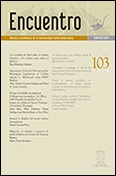Assessment of Genetic Diversity in Five Nicaraguan Populations of Cedrela odorata L. (Meliaceae) using RAPD Markers
DOI:
https://doi.org/10.5377/encuentro.v0i103.2690Keywords:
Cedrela odorata, Conservation, Genetic Diversity, Nicaragua, RAPDAbstract
The goal of this study was to assess the genetic diversity of Nicaraguan populations of Cedrela odorata using Random Amplified Polymorphic DNA (RAPD) markers. Thus, genomic DNA was isolated from leaf samples collected from ninety-two trees belonging to five Nicaraguan natural populations of C. odorata. The mean number of alleles per locus, effective number of alleles per locus, percentage of polymorphic loci, genetic diversity (He ) of Nei and diversity index (Ho ) of Shannon were estimated for each population assuming that the populations were in HardyWeinberg equilibrium. Total genetic diversity was partitioned in intrapopulational and interpopulational diversity using Nei’s genetic differentiation (GST) and through an Analysis of Molecular Variance (AMOVA). The ΦST matrix was used to construct a dendrogram by the neighbor-joining method. According to values of both He and Ho , Esquipulas (Deparment of Matagalpa) presented the lowest diversity level; while La Trinidad (Department of Estelí) showed the highest diversity level. Genetic differentiation was calculated obtaining a GST value of 13.36%. AMOVA also showed a similar differentiation value ΦST =13.81%). Neighbour-joining dendrogram clustered the five populations in two groups, where the group formed by La Trinidad and El Refugio (Department of Granada) presented the biggest differentiation. Correlation between genetic and geographical distances was not found.
Downloads
1088
Downloads
Published
How to Cite
Issue
Section
License
All published articles are licensed under the Creative Commons (BY, NC, SA), in the following terms: no commercial use of the original work or any derivative works, distribution of which must be done with a license equal to that which regulates the original work. This does not condition that the authors maintain their rights without restrictions. The journal allows authors to retain publication rights without restrictions.

Encuentro is licensed under a Creative Commons Attribution-NonCommercial-ShareAlike 4.0 International License.

